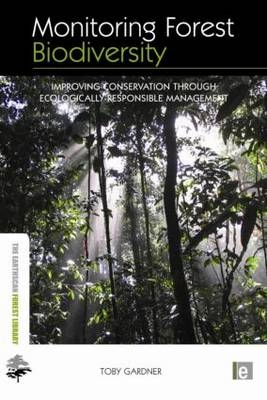
Monitoring Forest Biodiversity
Earthscan Ltd (Verlag)
978-1-84407-654-3 (ISBN)
The fate of much of the world's terrestrial biodiversity depends upon our ability to improve the management of forest ecosystems that have already been substantially modified by humans. Monitoring is an essential ingredient in meeting this challenge, allowing us to measure the impact of different human activities on biodiversity and identify more responsible ways of managing the environment. Nevertheless many biodiversity monitoring programs are criticised as being little more than 'tick the box' compliance exercises that waste precious resources and erode the credibility of science in the eyes of decision makers and conservation investors. The purpose of this book is to examine the factors that make biodiversity monitoring programs fail or succeed.
The first two sections lay out the context and importance of biodiversity monitoring, and shed light on some of the key challenges that have confounded many efforts to date. The third and main section presents an operational framework for developing monitoring programs that have the potential to make a meaningful contribution to forest management. Discussion covers the scoping, design and implementation stages of a forest biodiversity monitoring program, including defining the purpose, goals and objectives of monitoring, indicator selection, and the process of data collection, analysis and interpretation. Underpinning the book is the belief that biodiversity monitoring should be viewed not as a stand-alone exercise in surveillance but rather as an explicit mechanism for learning about how to improve opportunities for conservation. To be successful in this task, monitoring needs to be grounded in clear goals and objectives, effective in generating reliable assessments of changes in biodiversity and realistic in light of real-world financial, logistical and social constraints.
Toby Gardner is a NERC Research Fellow in the Conservation Science Group, Department of Zoology, University of Cambridge. For the past 10 years his research has focused on how to better understand and manage the impact of human activities on biodiversity in tropical ecosystems, including East Africa, the Caribbean and the Brazilian Amazon.
Foreword. Introduction. Part 1: The Context of Monitoring Forest Biodiversity. 1. Biodiversity Conservation in Human-Modified and Managed Forests. 2. The Origins and Development of Ecologically Responsible Forest Management. 3. The Need for Forest Biodiversity Monitoring. 4. A Typology of Approaches And Indicators for Monitoring Forest Biodiversity. Part 2: Challenges Facing Forest Biodiversity Monitoring. 5. Challenges to Monitoring: Problems of Purpose. 6. Challenges to Monitoring: Problems of Design. 7. Challenges to Monitoring: Problems of Reality. Part 3: An Operational Framework for Monitoring Forest Biodiversity. 8. Clarifying Purpose: An Operational Framework for Monitoring Forest Biodiversity. 9. Setting Conservation Goals for Biodiveristy Monitoring. 10. Setting Objectives for Biodiversity Monitoring. 11. Selecting Indicators of Forest Structure to Assess Management Performance. 12. Selecting Biological Indicators and Target Species to Evaluate Progress Towards Conservation Goals. 13. Making Assumptions Explicit: The Value of Conceptual Modelling in Biodiversity Monitoring. 14. Sampling Design and Data Collection in Biodiversity Monitoring. 15. Analysis and Interpretation of Biodiversity Data. 16. Putting Forest Biodiversity Monitoring to Work. Index.
| Erscheint lt. Verlag | 28.5.2010 |
|---|---|
| Reihe/Serie | The Earthscan Forest Library |
| Verlagsort | London |
| Sprache | englisch |
| Maße | 174 x 246 mm |
| Gewicht | 816 g |
| Themenwelt | Naturwissenschaften ► Biologie ► Botanik |
| Naturwissenschaften ► Biologie ► Ökologie / Naturschutz | |
| Naturwissenschaften ► Geowissenschaften ► Geografie / Kartografie | |
| Technik ► Umwelttechnik / Biotechnologie | |
| Weitere Fachgebiete ► Land- / Forstwirtschaft / Fischerei | |
| ISBN-10 | 1-84407-654-7 / 1844076547 |
| ISBN-13 | 978-1-84407-654-3 / 9781844076543 |
| Zustand | Neuware |
| Haben Sie eine Frage zum Produkt? |
aus dem Bereich


